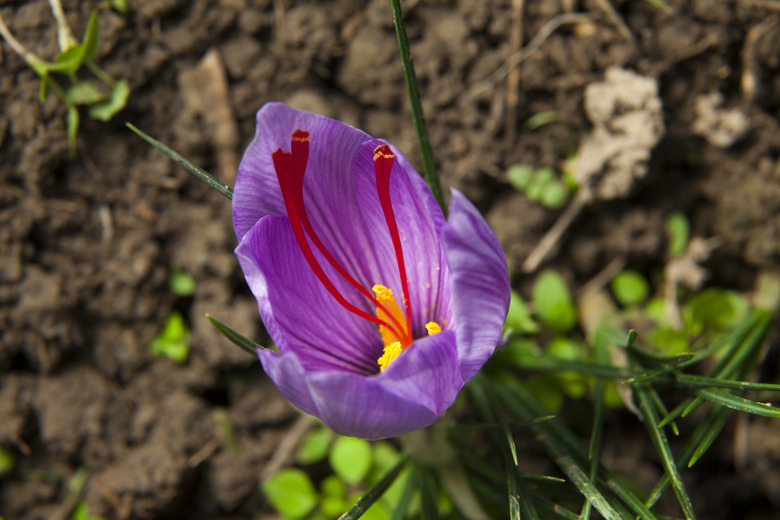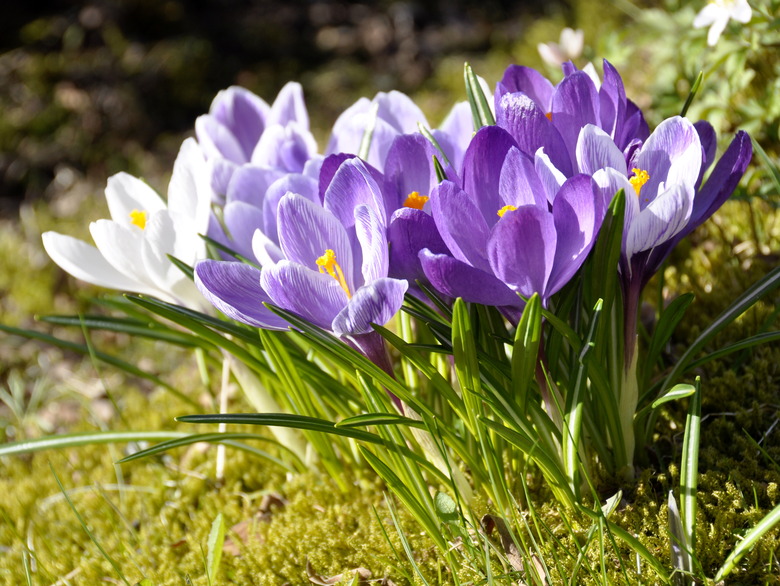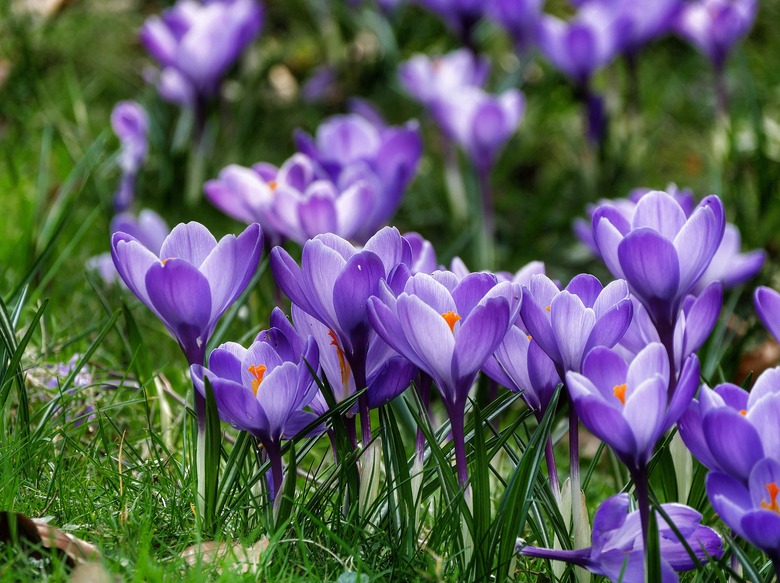How To Grow Saffron Crocus
The saffron crocus (Crocus sativus) is a small purple- or lavender-colored flower that is also known as autumn or saffron crocus. Each flower has three long, reddish-orange filaments at its center, and this is the source of the spice many home chefs know as saffron.
As a perennial in USDA plant hardiness zones 5 through 8, saffron crocus is an autumn bloomer, unlike spring-blooming Dutch and giant crocuses (Crocus spp., zones 3-9). They look very similar to springtime crocus flowers and don't grow much taller than 5 inches. Like their spring-blooming cousins, saffron crocuses don't require much effort to grow.
Why is the saffron spice so expensive? Each flower produces only three small reddish-orange saffron filaments, and it takes a considerable amount of flowers to harvest a very small usable amount, which is why the price point of saffron is so high. Because of this small availability, there's even a ton of fake saffron on the market. That said, home gardeners can easily grow enough flowers to harvest usable amounts of the spice for their culinary endeavors.
Saffron crocus requires little upkeep once plants are established in your yard or garden. The drought-tolerant plants are great for those looking for a showy, hands-off flower that blooms in autumn.
Best Uses for Saffron Crocus
Best Uses for Saffron Crocus
Saffron crocus is best planted straight in the ground wherever you want to enjoy a view of pretty flower clusters in the fall. You can also plant it in containers, but a swath of spread-out crocus flowers in a garden is really something beautiful to see. You can plant crocuses for their aesthetic benefit or grow them in order to harvest the filaments to flavor all sorts of dishes.
That said, don't expect to get a truckload of saffron threads. It takes thousands of flowers to produce a single pound of saffron. Still, you can harvest a few threads for the occasional fancy dish. Most recipes call for only a pinch of saffron anyway, since too much can be overwhelming.
If you plan to harvest saffron from these flowers, be aware that each flower only produces three saffron threads. So, you'll need to plant multiple crocus corms in order to get a usable harvest. The petals of the saffron crocus flowers are also very fragrant and can be used to make homemade potpourri.
Each year, the plants will multiply, leaving you with more and more flowers to enjoy. That means more saffron for the taking and a showy display in your yard or garden. Once established, autumn crocus plants don't require much upkeep aside from dividing them to prevent overcrowding, which can limit the dazzling autumn display.
How to Grow Saffron Crocus
How to Grow Saffron Crocus
You don't actually plant crocus from bulbs but from corms, which are bulblike structures. When it comes to spacing, plant saffron crocus corms about 4 inches apart and at a depth of 4 inches. Flowers usually come up after six to eight weeks, though sometimes, they only appear the following year after planting. Typically, the flowers stick around for about three weeks, and the grasslike foliage holds on for up to 12 weeks depending on your climate.
Ideally, you should plant crocus corms in a spot with well-draining soil that receives plenty of sunlight. However, the plants can handle a bit of shade. Don't bury the corms in an area where the soil is moist all summer long. The corms will be dormant throughout the summertime months and wet soil can cause them to rot, so pick a spot that's mostly dry during that time.
Once the plants wither away for the winter, it's tough to discern that they were even there. If you're worried about accidentally digging up the corms during spring gardening, you may want to mark the spot where they're planted. Unlike other plants and flowers, there's no need to prune or remove crocus foliage at the end of the growing season. The foliage will die back and provide nutrients for next year's flowers.
In What Zone Does Crocus Grow Best?
In What Zone Does Crocus Grow Best?
Saffron crocus is a perennial in USDA hardiness zones 5 to 8. You can grow the plant in these zones without having to worry about the corms surviving the winter. You'll need to dig up the corms in colder zones to protect them from harsh winters and store them indoors before planting them outdoors again in the spring.
Some people in zone 4b might be able to get away with leaving corms in the ground throughout the winter as long as soil temperatures don't go below -10 degrees Fahrenheit. However, if you choose to do this, it's a gamble that may not pay off. You can increase your chances of success by heavily mulching around your crocus plants to help insulate the soil. Don't forget to remove the mulch in the spring once your last frost date has passed.
When Should You Plant Crocus?
When Should You Plant Crocus?
Most companies that sell crocus corms will ship them at the right time for your zone and encourage you to plant them as soon as you receive them. It depends on your USDA growing zone, but planting usually occurs in August or September about six to eight weeks before your first frost date. You can also plant the corms in spring after the last frost but know that they won't flower until the fall.
Soil, Sunlight, and Water Recommendations for Crocus
Soil, Sunlight, and Water Recommendations for Crocus
Crocus plants prefer a lot of sun but will still grow in partial shade. Soil needs to drain well, and high-moisture areas should be avoided. Pick a spot with dry, sandy soil for best results.
Crocus plants are drought tolerant and don't usually require any specialized care, including watering. In fact, it's best if the planting area is relatively dry throughout the summer while the corms are dormant. Excess water during the dormancy period can lead to root rot and disease. In the fall when the flowers bloom, you can hold off on watering if your area gets at least 1 1/2 inches of rain per week.
How to Propagate Saffron Crocus
How to Propagate Saffron Crocus
Crocus multiplies every year by producing new corms. However, after about four to six years, perennial crocus can become overcrowded. You can divide and replant the corms any year. Do this as soon as the blooms and foliage begin to fade at the tail-end of the fall. Unsure of when to divide crocus? It's also OK to wait a few years. When flower numbers begin to stagnate or decrease, it's definitely a sign that it's time to divide the corms.
To divide corms, wait until the flowers and foliage die back. Dig up the corms and rinse away any soil. You'll be able to spot the cormels, which crop up at the base of the mother corm. These small pieces eventually separate from the central corm and become offshoot plants. Remove these. They're usually easy to pull off with your fingers. Once you're done taking these off the main corm, replant them. Don't forget to keep crocus spacing guidelines in mind.
How to Winterize Saffron Crocus
How to Winterize Saffron Crocus
You can grow crocus in places colder than zone 5, but you'll need to do a bit of extra work to keep your plants alive. To preserve the corms for the next season, dig them up and bring them inside for the winter. You can do this after the first frost in the fall but do it before the ground is completely frozen and unworkable.
To keep the corms dormant until next year, put them in a large container or bucket and fill it with sand. Keep the bucket in a cool, dry location like a pantry or a very dry basement. In the spring, plant the corms after your last frost date. If locating and digging up the corms seems like an annoying task to undertake every year, you can make it a bit easier by planting the corms inside containers or buckets that you plant deeply in the ground. In zones 5 through 8, you don't need to worry about winterizing saffron crocus.
How to Harvest Saffron Crocus
How to Harvest Saffron Crocus
You can grow saffron crocus in order to harvest the earthy-tasting threads that emanate from the center of each flower. To gather the saffron pieces, wait until the flowers bloom. The threads need to be harvested right away. Harvest at midday when the cup-shaped flowers are fully open as they close at night and on gloomy days.
Gently pluck the red-orange threads from the flowers and bring them inside. Spread them onto a baking sheet and leave them to dry at room temperature. You'll know they're dry enough because they'll crumble easily when touched. You can keep the dried threads in an airtight container for several years.
Common Pests and Other Problems for Crocus
Common Pests and Other Problems for Crocus
Small rodents can be a problem for plants with corms. If you've had issues with voles or mice in the past, apply a barrier like wire mesh before planting the corms. They're the most likely culprit if you're noticing saffron crocus damage. Bunnies and other animals are notorious for munching on the tender green growth of all kinds of crocus plants, including saffron crocus. They also eat and displace corms. Squirrels sometimes disturb dormant corms when burying and uprooting food. Deep plantings may deter rodents, but it's not a guarantee.
While insect pests aren't a huge problem for saffron crocus, they can still appear and cause issues. Mites, for instance, can enter the plants via nicks and scratches in the corms and leave behind a plant with stunted, yellowed leaves. A miticide can help combat them. Thrips can also cause foliage damage. They cause yellow and white spotting, but the damage isn't usually fatal. A light application of neem oil is usually enough to mitigate the problem.
Common Diseases for Crocus
Common Diseases for Crocus
Saffron crocus is susceptible to fungal diseases and root rot if planted in a wet area, especially if conditions are very moist during the blooming period. Some examples of fungal diseases that affect saffron crocus include Aspergillus and Rhizopus. Planting on soil with good drainage is the best way to prevent these kinds of diseases. You can also prevent the problem by spraying corms with fungicide before planting.


